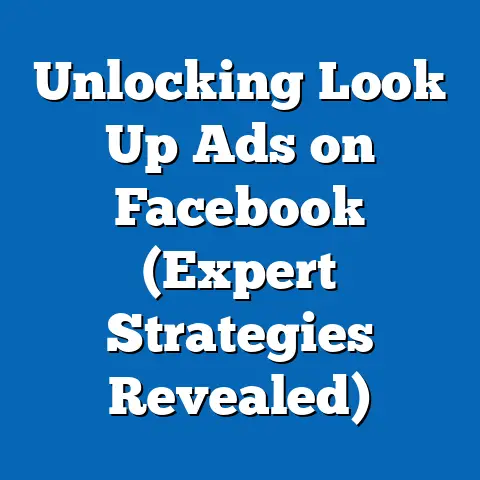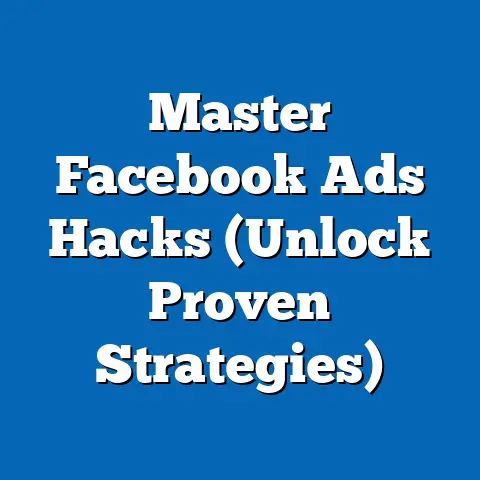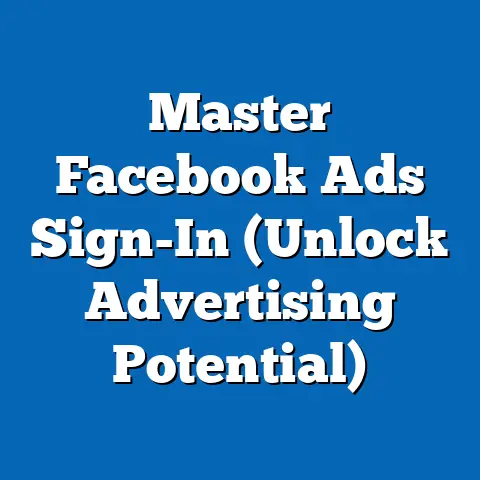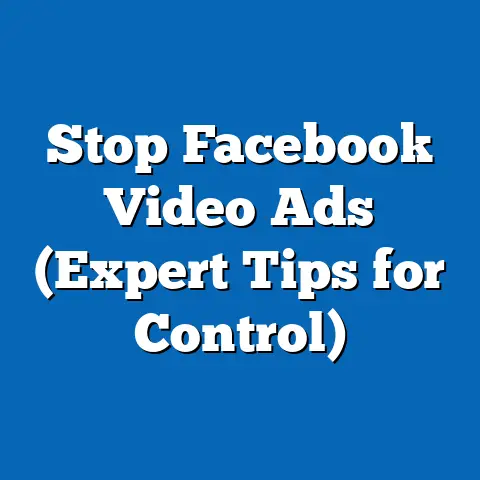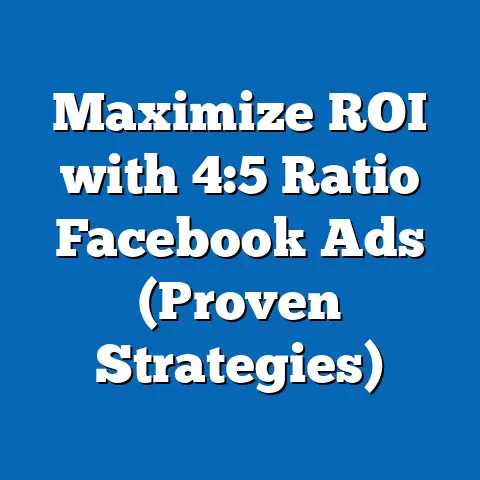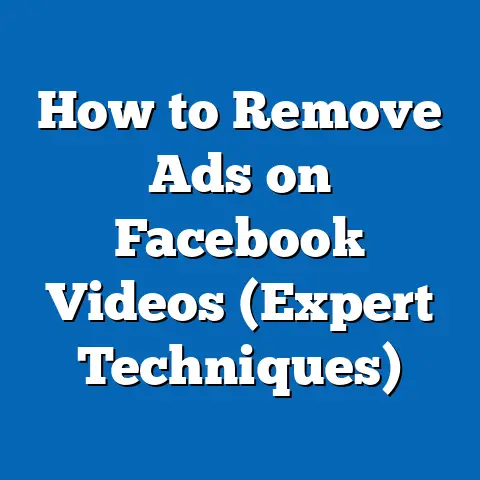Profitable Facebook Ad Markets (Insider Tips Revealed)
Profitable Facebook Ad Markets: Insider Tips Revealed
Imagine Sarah, a passionate baker with a small online shop selling artisanal cookies. She poured her heart into her business, crafting unique flavors and beautifully packaging each order. But despite her efforts, sales were stagnant. She tried everything – local markets, Instagram posts, even a small Google Ads campaign. Nothing seemed to work.
Then, one evening, while scrolling through a Facebook group for baking enthusiasts, she stumbled upon a thread discussing Facebook advertising. Intrigued, she started researching. She learned about audience targeting, ad creatives, and the power of reaching the right people. Overwhelmed but determined, she decided to give it a shot.
After a few weeks of experimentation and a lot of tweaking, Sarah finally cracked the code. She discovered a niche market – gluten-free cookie lovers with a penchant for unique flavors. By targeting this specific audience with mouthwatering images and compelling ad copy, her sales skyrocketed. Sarah’s small online shop went from struggling to keep the lights on to fulfilling hundreds of orders each week. The relief and excitement she felt were palpable. This is the power of finding a profitable Facebook ad market.
This article isn’t just about Sarah’s story; it’s about equipping you with the knowledge and tools to replicate her success. We’ll explore the Facebook advertising landscape, identify profitable niches, leverage the platform’s features, craft compelling ad content, and analyze performance to scale your wins.
Understanding the Facebook Advertising Landscape
Facebook advertising has come a long way since its early days. What started as simple banner ads has evolved into a sophisticated ecosystem with advanced targeting options, diverse ad formats, and powerful analytics. Today, Facebook ads are an indispensable part of any successful digital marketing strategy.
Why Facebook Ads Still Matter (and Why You Should Care)
- Massive Reach: With over 2.9 billion monthly active users, Facebook offers unparalleled reach to businesses of all sizes. No matter your target audience, you’re likely to find them on Facebook.
- Granular Targeting: Facebook’s targeting capabilities are incredibly precise. You can target users based on demographics, interests, behaviors, and even life events. This allows you to reach the exact people who are most likely to be interested in your products or services.
- Diverse Ad Formats: From image ads to video ads, carousel ads to collection ads, Facebook offers a variety of ad formats to suit different marketing objectives.
- Measurable Results: Facebook provides detailed analytics that allow you to track the performance of your ads and measure your return on investment (ROI).
According to Statista, Facebook’s ad revenue reached nearly $115 billion in 2022, highlighting the platform’s significance in the advertising industry. This figure underscores the immense potential for businesses to generate revenue through Facebook ads.
The Rise of “Profitable Markets” Within Facebook Ads
But here’s the thing: not all Facebook ads are created equal. Simply running ads on Facebook doesn’t guarantee success. To truly thrive, you need to identify and target profitable markets. These are specific niches or segments of the Facebook audience that are highly receptive to your products or services and offer a high ROI for your ad spend.
Think of it like fishing. You can cast your net anywhere in the ocean, but you’re more likely to catch something if you know where the fish are swimming. Similarly, by identifying and targeting profitable markets, you can dramatically increase the effectiveness of your Facebook ads and achieve your marketing goals.
Key Takeaway: Facebook advertising offers incredible potential for businesses, but success depends on understanding the platform and targeting profitable markets.
Identifying Profitable Niches
Finding a profitable niche is the cornerstone of successful Facebook advertising. It’s about identifying those pockets of the Facebook universe where demand is high, competition is relatively low, and audiences are passionate about specific products or services.
Characteristics of a Profitable Facebook Ad Market:
- High Demand: There’s a significant need or desire for the product or service within the target audience.
- Less Competition: Fewer businesses are actively targeting the same audience, giving you a higher chance of standing out.
- Passionate Audiences: The target audience is deeply invested in the niche, making them more likely to engage with your ads and make purchases.
- Clear Pain Points: You can identify and address specific problems or frustrations that the target audience experiences.
- Willingness to Spend: The target audience is willing to spend money on products or services that solve their problems or fulfill their desires.
Examples of Niches That Often Thrive on Facebook:
- Health and Wellness: This niche encompasses a wide range of products and services, from fitness programs and supplements to mental wellness apps and mindfulness courses. The key is to target specific segments within this niche, such as yoga enthusiasts, vegan athletes, or individuals struggling with anxiety.
- E-commerce (Niche Products): Instead of selling generic products, focus on niche items that cater to specific interests or hobbies. Examples include artisanal coffee beans, handmade jewelry, or eco-friendly home goods.
- Online Education: The demand for online courses and educational resources is booming. Consider offering courses on topics such as digital marketing, coding, or creative writing.
- Pet Products: Pet owners are incredibly passionate about their furry friends and are willing to spend money on high-quality food, toys, and accessories.
- Sustainable Living: As consumers become more environmentally conscious, the demand for sustainable products and services is growing.
- Home Improvement (DIY): Homeowners are always looking for ways to improve their living spaces, making DIY projects and home decor items a popular niche.
The Importance of Market Research and Audience Targeting
So how do you identify these hidden gems of profitable niches? It all starts with market research and audience targeting.
- Facebook Audience Insights: This powerful tool allows you to analyze the demographics, interests, and behaviors of Facebook users. You can use it to identify potential niches and understand their preferences.
- Competitor Analysis: Research your competitors to see what niches they’re targeting and what strategies they’re using. This can give you valuable insights into what’s working and what’s not.
- Keyword Research: Use keyword research tools like Google Keyword Planner to identify popular search terms related to your niche.
- Social Listening: Monitor social media conversations to understand what people are talking about in your niche. This can help you identify emerging trends and pain points.
- Surveys and Polls: Conduct surveys and polls to gather feedback from your target audience. Ask them about their needs, preferences, and challenges.
My Experience: I once worked with a client who was selling handmade leather journals. Initially, they were targeting a broad audience interested in “journals” and “stationery.” The results were underwhelming. After digging deeper, we discovered a niche market of writers and artists who were specifically interested in vintage-style leather journals. By targeting this niche with ads showcasing the craftsmanship and unique aesthetic of the journals, we saw a significant increase in sales and engagement.
Key Takeaway: Identifying profitable niches requires thorough market research and precise audience targeting. Use Facebook Audience Insights, competitor analysis, and social listening to uncover hidden opportunities.
Leveraging Facebook’s Ad Tools and Features
Facebook isn’t just a platform for connecting with friends and family; it’s also a powerful advertising platform packed with tools and features designed to help you find and target profitable markets.
Diving Deep into Facebook Ad Tools:
- Audience Insights: As mentioned earlier, this tool is invaluable for understanding your target audience. You can analyze their demographics, interests, behaviors, and even their purchase history. Use it to identify potential niches and refine your targeting.
- Lookalike Audiences: This feature allows you to create audiences that are similar to your existing customers or website visitors. By targeting lookalike audiences, you can reach new people who are likely to be interested in your products or services.
- Custom Audiences: Create custom audiences based on your own data, such as email lists, website traffic, or app activity. This allows you to target your ads to people who have already interacted with your business.
- A/B Testing: Experiment with different ad creatives, targeting options, and bidding strategies to see what works best. A/B testing is essential for optimizing your campaigns and maximizing your ROI.
- Facebook Pixel: This small piece of code tracks the actions that people take on your website after clicking on your Facebook ad. This data allows you to measure the effectiveness of your ads and optimize your campaigns for conversions.
- Campaign Budget Optimization (CBO): Let Facebook’s algorithm automatically allocate your budget across different ad sets based on performance. This can help you get the most out of your budget and improve your overall ROI.
- Advantage Campaign Budget (formerly known as Campaign Budget Optimization): Meta’s AI-powered budget optimization tool, designed to automatically allocate your budget across different ad sets within a campaign, aiming to achieve the best possible results. It learns from real-time performance data and dynamically adjusts budget allocation to focus on the most promising ad sets.
Insider Tips for Optimizing Ad Placements, Formats, and Messaging:
- Ad Placements: Don’t just stick to the default Facebook News Feed placement. Experiment with different placements, such as Instagram Feed, Audience Network, and Messenger. Each placement has its own unique audience and characteristics.
- Ad Formats: Choose the ad format that best suits your marketing objective and target audience. Image ads are great for showcasing products, video ads are perfect for storytelling, and carousel ads are ideal for displaying multiple products or features.
- Messaging: Craft compelling ad copy that speaks directly to your target audience. Highlight the benefits of your product or service and address their specific pain points. Use a clear and concise call-to-action to encourage them to take the next step.
Real-World Example: I worked with an e-commerce client who was selling organic skincare products. They were initially running ads targeting a broad audience interested in “skincare” and “beauty.” We decided to use Facebook Audience Insights to identify a more specific target audience. We discovered a niche market of environmentally conscious consumers who were specifically interested in organic and cruelty-free skincare products. By targeting this niche with ads highlighting the natural ingredients and ethical practices of the brand, we saw a significant increase in sales and engagement. We also experimented with different ad formats, finding that video ads showcasing the production process and customer testimonials performed particularly well.
Key Takeaway: Facebook offers a wealth of tools and features to help you find and target profitable markets. Leverage these tools to optimize your ad placements, formats, and messaging for maximum impact.
Crafting Compelling Ad Content
Even the most precisely targeted ad will fall flat if the content doesn’t resonate with your audience. Compelling ad content is the bridge that connects your product or service with the needs and desires of your target market.
The Elements of High-Performing Ad Creative:
- Eye-Catching Visuals: Use high-quality images or videos that grab attention and convey the essence of your brand. Make sure your visuals are relevant to your target audience and the message you’re trying to communicate.
- Compelling Copy: Write clear, concise, and engaging ad copy that highlights the benefits of your product or service. Use strong verbs, sensory language, and emotional appeals to connect with your audience.
- Clear Call-to-Action (CTA): Tell your audience exactly what you want them to do. Use a strong and specific CTA, such as “Shop Now,” “Learn More,” or “Sign Up Today.”
- Relevance: Ensure your ad content is relevant to your target audience and their interests. Tailor your messaging and visuals to resonate with their specific needs and desires.
- Value Proposition: Clearly communicate the value that your product or service offers. What problem does it solve? What benefits does it provide?
The Power of Storytelling in Ads:
People are naturally drawn to stories. By incorporating storytelling into your ads, you can capture attention, build trust, and create an emotional connection with your audience.
- Focus on the Customer: Tell stories about how your product or service has helped other customers. Highlight their successes and transformations.
- Use Authentic Voices: Feature real people in your ads, not just actors or models. This will make your story more relatable and believable.
- Create Emotional Connections: Tap into the emotions of your target audience. What are their hopes, fears, and aspirations?
- Keep it Concise: Your story should be brief and to the point. Don’t try to cram too much information into a single ad.
Examples of Successful Ads:
- Dollar Shave Club: Their viral video ad was a masterclass in humor and storytelling. It was funny, memorable, and effectively communicated the value proposition of their product.
- Nike: Their “Just Do It” campaign is a timeless example of inspirational advertising. It tapped into the emotions of athletes and encouraged them to push their limits.
- Airbnb: Their ads often feature stories of travelers experiencing new cultures and connecting with local communities. This resonates with their target audience who are looking for unique and authentic travel experiences.
My Personal Experience: I once helped a local restaurant create a series of Facebook ads. Instead of just showcasing their menu items, we decided to tell stories about the people behind the restaurant – the chefs, the servers, and the loyal customers. We created short videos featuring interviews and behind-the-scenes footage. These ads resonated deeply with the local community and helped the restaurant build a strong brand identity.
Key Takeaway: Crafting compelling ad content is essential for capturing attention and driving engagement. Use eye-catching visuals, compelling copy, a clear CTA, and the power of storytelling to connect with your audience on an emotional level.
Budgeting and Bidding Strategies
Now that you’ve identified a profitable niche and crafted compelling ad content, it’s time to talk about the money. Budgeting and bidding are crucial aspects of Facebook advertising that can significantly impact your ROI.
How to Allocate Budgets Effectively:
- Start Small: Don’t invest all your money in one go. Start with a small budget and gradually increase it as you see positive results.
- Test and Iterate: Use your budget to test different ad creatives, targeting options, and bidding strategies. Once you identify what works best, allocate more budget to those campaigns.
- Consider Your Goals: Your budget should align with your marketing objectives. Are you trying to generate leads, drive sales, or increase brand awareness?
- Track Your ROI: Monitor your ROI closely and adjust your budget accordingly. If you’re not seeing a positive return, it’s time to re-evaluate your strategy.
Understanding Bidding Strategies:
Facebook offers a variety of bidding strategies to suit different marketing objectives.
- Cost-Per-Click (CPC): You pay each time someone clicks on your ad. This is a good option if you’re trying to drive traffic to your website.
- Cost-Per-Impression (CPM): You pay for every 1,000 impressions your ad receives. This is a good option if you’re trying to increase brand awareness.
- Cost-Per-Action (CPA): You pay each time someone takes a specific action, such as making a purchase or signing up for a newsletter. This is a good option if you’re trying to generate leads or drive sales.
- Lowest Cost: Meta tries to get you the most results possible for your budget. Great for when you don’t have a target cost in mind.
- Cost Cap: You set a maximum amount you’re willing to pay per result, giving you more control over your spending.
- Target Cost: Meta aims to get you results as close to your target cost as possible.
Choosing the Right Bidding Strategy:
The best bidding strategy for you will depend on your marketing objectives, target audience, and budget.
- If you’re new to Facebook advertising, start with CPC or CPM to get a feel for how your ads are performing.
- If you’re trying to drive sales, CPA is a good option, but it requires accurate tracking and attribution.
- If you’re trying to increase brand awareness, CPM is a cost-effective choice.
Monitoring and Adjusting Budgets:
Your budget and bidding strategy should not be set in stone. Monitor your performance closely and adjust your strategy as needed.
- Track Your Key Performance Indicators (KPIs): Monitor metrics such as click-through rate (CTR), conversion rate, and cost-per-conversion.
- Identify Underperforming Campaigns: If a campaign is not performing well, consider pausing it or re-evaluating your targeting and ad creative.
- Scale Successful Campaigns: If a campaign is performing well, consider increasing your budget to reach a wider audience.
My Experience with Budgeting: I remember working with a startup that had a limited advertising budget. Instead of trying to compete with the big players, we focused on targeting a very specific niche audience with highly relevant ads. We started with a small budget and gradually increased it as we saw positive results. By being strategic with our budgeting and bidding, we were able to achieve a significant ROI despite our limited resources.
Key Takeaway: Budgeting and bidding are essential for maximizing your ROI on Facebook ads. Start small, test and iterate, consider your goals, and monitor your performance closely.
Analyzing Performance and Scaling Success
You’ve launched your Facebook ad campaigns, and now it’s time to analyze the results and scale your success. Data is your best friend in this phase.
Key Performance Indicators (KPIs) to Track:
- Click-Through Rate (CTR): The percentage of people who click on your ad after seeing it. A high CTR indicates that your ad is relevant and engaging.
- Conversion Rate: The percentage of people who take a desired action, such as making a purchase or signing up for a newsletter, after clicking on your ad. A high conversion rate indicates that your landing page is effective and your offer is compelling.
- Cost-Per-Click (CPC): The amount you pay each time someone clicks on your ad. A low CPC indicates that your ad is efficient and you’re targeting the right audience.
- Cost-Per-Conversion (CPC): The amount you pay for each conversion. A low CPA indicates that your campaign is profitable.
- Return on Ad Spend (ROAS): The amount of revenue you generate for every dollar you spend on advertising. A high ROAS indicates that your campaign is highly profitable.
- Reach: The number of unique people who saw your ad.
- Frequency: The average number of times each person saw your ad.
Step-by-Step Guide to Analyzing Ad Performance Data:
- Set Up Tracking: Ensure you have proper tracking in place, including the Facebook Pixel and conversion tracking.
- Gather Data: Collect data from your Facebook Ads Manager over a specific period (e.g., one week, one month).
- Identify Trends: Look for patterns and trends in your data. Which ad creatives are performing best? Which targeting options are generating the most conversions?
- Segment Your Data: Segment your data by demographics, interests, and behaviors to identify which segments are most responsive to your ads.
- Calculate Your ROI: Calculate your ROI for each campaign and ad set. This will help you identify which campaigns are most profitable.
- Draw Conclusions: Based on your data analysis, draw conclusions about what’s working and what’s not.
- Take Action: Implement changes to your campaigns based on your data analysis. Optimize your ad creatives, refine your targeting, and adjust your bidding strategy.
Strategies for Scaling Successful Ad Campaigns:
- Increase Your Budget: If a campaign is performing well, consider increasing your budget to reach a wider audience.
- Expand Your Targeting: Identify new targeting options that are similar to your existing target audience.
- Create Lookalike Audiences: Use Facebook’s lookalike audience feature to reach new people who are similar to your existing customers.
- Run Retargeting Campaigns: Target people who have already interacted with your business, such as website visitors or email subscribers.
- Experiment with New Ad Formats: Try new ad formats to see if they resonate with your audience.
A Scaling Success Story: I was consulting for a subscription box company that was targeting a broad audience of “lifestyle enthusiasts.” After analyzing their data, we discovered that their most loyal customers were women aged 25-34 who were interested in sustainable living and ethical fashion. We created a lookalike audience based on these customers and launched a retargeting campaign targeting website visitors who had abandoned their shopping carts. These campaigns generated a significant increase in sales and helped the company scale their business.
Key Takeaway: Analyzing performance and scaling success requires a data-driven approach. Track your KPIs, analyze your data, and implement changes to your campaigns based on your findings.
Future Trends in Facebook Advertising
The world of Facebook advertising is constantly evolving. Staying ahead of the curve requires keeping an eye on emerging trends and adapting your strategies accordingly.
Key Trends to Watch:
- Artificial Intelligence (AI): AI is already playing a significant role in Facebook advertising, and its influence will only continue to grow. AI-powered tools can help you automate tasks, optimize your campaigns, and personalize your ads.
- Augmented Reality (AR): AR is becoming increasingly popular in advertising. AR ads allow users to interact with your products in a virtual environment, creating a more engaging and immersive experience.
- Video Advertising: Video is the dominant form of content on social media, and its importance in advertising will only continue to grow. Create engaging and informative video ads that capture attention and tell your brand story.
- Personalization: Consumers are demanding more personalized experiences. Use data and AI to create ads that are tailored to the individual needs and preferences of your target audience.
- Privacy: As concerns about data privacy continue to grow, Facebook is making changes to its platform to protect user data. Stay informed about these changes and adapt your strategies accordingly.
How Businesses Can Stay Ahead of the Curve:
- Stay Informed: Read industry blogs, attend conferences, and follow thought leaders to stay up-to-date on the latest trends.
- Experiment: Don’t be afraid to experiment with new ad formats, targeting options, and bidding strategies.
- Adapt: Be prepared to adapt your strategies as the Facebook advertising landscape evolves.
- Focus on Value: Create ads that provide value to your target audience. Don’t just focus on selling your products or services; focus on solving their problems and fulfilling their needs.
My Predictions for the Future: I believe that AI will play an even greater role in Facebook advertising in the coming years. AI-powered tools will help businesses automate tasks, optimize their campaigns, and personalize their ads at scale. I also believe that video advertising will continue to dominate the landscape, and businesses will need to create engaging and informative video content to capture attention.
Key Takeaway: Staying ahead of the curve in Facebook advertising requires staying informed about emerging trends, experimenting with new strategies, and adapting to changes in the platform.
Conclusion
Facebook advertising offers incredible potential for businesses to unlock profitable markets and achieve their marketing goals. By understanding the platform, identifying your niche, crafting compelling ad content, budgeting effectively, analyzing your performance, and staying ahead of the curve, you can transform your business from struggling to thriving.
Remember Sarah, the baker? She started with a passion and a product, but it was her willingness to learn and adapt that ultimately led to her success. You too can unlock the power of Facebook ads and achieve your dreams.
So, take the insights and tips shared throughout this article and apply them to your own advertising strategies. Start small, test and iterate, and never stop learning. With the right approach, your business can thrive in the competitive landscape of Facebook advertising. Good luck, and I can’t wait to see what you achieve!

